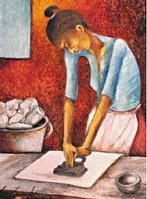
Guy Coombs 'Girl Ironing' oil on canvas.-Sana Rose photo
Sana Rose, Contributor
'PRIVATE IMAGES', a joint exhibition by painter Guy Coombs and ceramic sculptor Uhuru (Keith Reece) is currently on view at the Bolivar Gallery. Coombs offers a small collection of genre scenes in praise of the routine of daily life in downtown Kingston where he grew up, while Uhuru fuses and references African, Pre-Colombian and Far East spirituality with a trace of Greek mythology and superimposes these with sexual overtones.
Separately titled 'Recent Paintings', Coombs' offering has a distinctly different conceptual tone and temperament than that of his fellow exhibitor. His paintings reflect ordinary life and do not make overt social statements. The images seem to be born of quiet contemplation, a state of mind with which the artist unobtrusively invites the viewer to engage.
CHARACTER TYPES
His portraits and caricatures of familiar character types in city, semi-rural and private home settings with people walking along streets, engaged in work, worship and recreation recall the works of Albert Huie, Alexander Cooper and David Pottinger especially, whose approach to painting and choice of subjects are similar.
Coombs' approach consists of elongated bodies, dark but softened outlines; rich warm colours and implied texture. All done in oil on canvas within the last two years, works such as 'Street Scene' and 'Corner Shop' are reminiscent of David Pottinger while 'Study in Nude' recalls Albert Huie and 'Stand Pipe' utilises the semi-abstract composition of Alexander Cooper's work of the 1960s.
In 'Girl Ironing' the artist patterns his painting from Pablo Picasso's 1904 painting 'Woman Ironing', making minor changes to the composition and paints it with a warmer colour scheme. Coombs clearly identifies with the early Modernist approach to image-making and like his fellow Jamaicans, retains native themes.
Meanwhile, Uhuru's sculptures, dubbed "20 Years of Mystic Ceramics", may give the impression of figurines particularly because of their small scale and their display in wooden cabinets. Closer inspection reveals that these works are not merely curio items but the product of a conceptual preoccupation which spans 20 years.EROTIC IMAGESHis unabashedly erotic images are superimposed with religious references and the fusion is seamless. The artist has managed to combine seemingly disparate elements into a unique voice. The combination of
fleshly desires and religious symbols, such as the swastika and cross and references are moulded into hybrid human and animal forms, masks/faces, painted patterns, musical elements and phallic and anthropomorphic structures with a smidgen of Surrealist flair.
The result is a conceptual assemblage of meaning. His visual temperament is somewhat similar to self-taught artist, David Marchand, who creates actual assemblages of found objects and collage in his work to discuss a wide array of themes, including religion.
Uhuru does not create his layers of meaning through the use of recontextualised found objects or collage, but instead moulds his own forms from scratch and encodes them with symbols and the language of the body in clay.
However, where Marchand uses sardonic humour, Uhuru is more sober in his concepts, but at the same time, imaginative in his imagery, and even if his forms or titles prompt a chuckle, we sense an underlying intensity.Uhuru's main subjects are the body and the head/face, which often translates into masks. He employs mainly moderately stylised female nudes in their entirety and emphasises the reproductive areas of the bodies in similar fashion to African art. Whether or not the male body is present, the phallus or phallic-like forms (cylindrical protuberances and creatures) become the main the object of desire and temptation. The robust forms display well-defined muscle tone and in the case of the female body, exaggerated anatomical detail.
STYLISED RIBS
These forms are often imbued with stylised ribs and stomachs and their lips, nipples, pubic area which is also enhanced by actual hair and nails are painted in bright red and blue paint leaving most of the surface area untouched and showing only the natural red-brown earthenware clay colour.Reinforced with grog, the forms have a gritty texture in addition to the artist's efforts at not smoothing out the clay
completely.
Uhuru's eroticism is not purely intent on describing or commenting on male/female sexual relationships as for the most part he uses it as a metaphor against ideals of spirituality or holiness.
PIECES
In other pieces where the pre-Columbian and African influences are strongest such as 'Ancestor', 'Two Head Horns' and 'Ritual Mask', worship is a prospect but not an absolute. We sense that we could take the pieces home like the Tainos would their zemis (gods) but Uhuru does not beckon us to worship, he merely presents the possibility and leaves us to decipher cryptic visual message.The exhibitions brings together two artists of vastly
different conceptual interests and their only common ground seems to be that of representational depictions of the human form. But, strangely enough, we are not put off by this fact as the artists do not encroach on each other's space or create a desperately incongruous union. While Uhuru holds our attention longer (as he has given us more to look at and contemplate), we find sincerity in both artists in Coombs, an extraordinary affinity for things ordinary, and in Uhuru, a commitment to working through an idea.
The images still remain private despite being brought into the public domain as the intensely personal aura of the artists' visions is never lost as they
quietly speak volumes. 'Private Images' closes on March 13.

